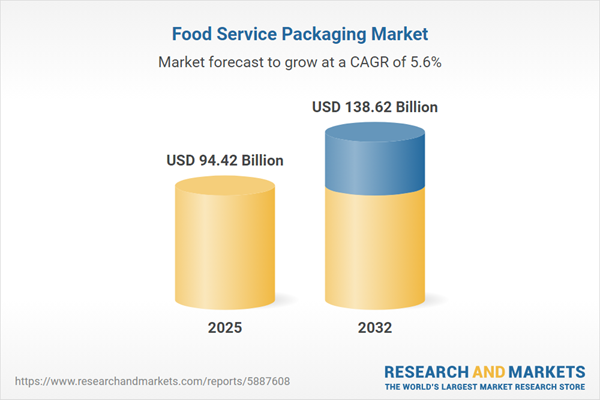Speak directly to the analyst to clarify any post sales queries you may have.
The food service packaging market is rapidly evolving as sustainability imperatives, digital transformation, and regional regulations converge. Senior leaders are reassessing packaging portfolios to meet rising consumer, regulatory, and operational expectations, while advancing environmental and supply chain strategies.
Market Snapshot: Food Service Packaging Market Growth Trajectory
The Food Service Packaging Market grew from USD 89.61 billion in 2024 to USD 94.42 billion in 2025. It is expected to continue growing at a CAGR of 5.60%, reaching USD 138.62 billion by 2032. This signals robust market momentum driven by shifts in consumer habits, regulatory tightening, and technological advancements.
Scope & Segmentation of the Food Service Packaging Market
This comprehensive report analyzes critical dimensions and trends influencing industry performance globally and regionally.
- Packaging Types: Flexible packaging (films, pouches, wrappers) and rigid packaging (boxes, cartons, clamshells, cups, containers, paper bags, trays) offer tailored solutions for product protection, presentation, and convenience.
- Material Options: Choices include aluminum, glass, paper and paperboard, as well as plastics such as polyethylene (PE), polyethylene terephthalate (PET), polypropylene (PP), and polystyrene (PS).
- Sustainability Approaches: Reusable packaging supports circularity while single-use formats provide efficiency for quick service models.
- Functional Applications: Beverage and food packaging adapted to cold and hot drinks, bakery and confectionery, dairy products, fruits and vegetables, fresh and cooked meat, poultry, seafood, and ready meals.
- End-User Segments: Coffee shops, kiosks, catering services, full-service restaurants, institutional and quick service operators feature unique needs and regulatory environments.
- Distribution Channels: Offline networks (wholesale, foodservice distribution, direct store delivery) and online channels supporting e-commerce fulfillment and meal kit subscriptions.
- Regional Focus: Coverage spans North America, Latin America, Europe, Middle East, Africa, and Asia-Pacific, each with distinctive consumption preferences and compliance challenges.
- Leading Companies: Analysis includes updates from major players such as Anchor Packaging LLC, Be Green Packaging LLC, BioPak Pty Ltd, Cascades Inc., CKF Inc., Coveris Management GmbH, D&W Fine Pack LLC, Dart Container Corporation, Detmold Group, Eco-Products Inc., Genpak LLC, Georgia-Pacific LLC, Graphic Packaging International LLC, Hotpack Packaging Industries LLC, Huhtamaki Oyj, Inline Plastics Corp., Novolex Holdings LLC, Pactiv Evergreen Inc., Placon Corporation, Reynolds Consumer Products Inc., Sabert Corporation, Smurfit Kappa Group plc, Sonoco Products Company, Vegware Ltd, and WinCup Inc.
Key Takeaways for Strategic Decision-Making
- Operators are expanding recyclable and compostable offerings to align with shifting regulatory and consumer demands for waste reduction.
- Integration of digital printing, smart sensors, and automation enhances operational agility and facilitates rapid adaptation to menu and branding changes.
- Material innovation, including emergent bio-based polymers and advanced coatings, is redefining product lifecycles and supporting differentiated sustainability claims.
- Collaboration across the supply chain, particularly with recycling and waste management partners, advances closed-loop solutions and builds resilience against supply disruptions.
- Regional compliance requirements around recycled content, material bans, and environmental stewardship drive innovation in both legacy and emerging markets.
- Companies adopting multi-regional sourcing and nearshoring are mitigating risks posed by evolving trade and tariff regimes.
Tariff Impact on the Food Service Packaging Market
Recent United States tariff policies have introduced added cost pressures across global food service packaging supply chains. Manufacturers are actively reorienting procurement, forming domestic partnerships, and pursuing lightweighting to offset escalating input prices. These measures, while initially a challenge, are also sparking product innovation and new supply relationships that strengthen long-term competitiveness.
Methodology & Data Sources
This research combines in-depth primary interviews with senior executives, R&D leaders, procurement managers, and sustainability officers with analysis of secondary sources such as industry reports and regulatory disclosures. Rigorous segmentation and scenario modeling ensure the accuracy and relevance of findings.
Why This Report Matters
- Senior leaders can benchmark their packaging strategies against industry and regional peers to capitalize on emerging market opportunities and compliance requirements.
- Actionable segmentation insights allow precise targeting of investment in materials, end-user applications, and new technologies to maximize impact and sustainability.
- Supporting informed risk mitigation, the analysis enables proactive adaptation to change, from shifting consumer trends to regulatory updates and supply chain volatility.
Conclusion
This report equips executives with strategic guidance for achieving growth through sustainable innovation, operational resilience, and informed market positioning. Aligning packaging solutions to evolving industry demands will shape leaders’ success in a dynamic, competitive landscape.
Additional Product Information:
- Purchase of this report includes 1 year online access with quarterly updates.
- This report can be updated on request. Please contact our Customer Experience team using the Ask a Question widget on our website.
Table of Contents
3. Executive Summary
4. Market Overview
7. Cumulative Impact of Artificial Intelligence 2025
Companies Mentioned
The companies profiled in this Food Service Packaging market report include:- Anchor Packaging LLC
- Be Green Packaging LLC
- BioPak Pty Ltd
- Cascades Inc.
- CKF Inc.
- Coveris Management GmbH
- D&W Fine Pack LLC
- Dart Container Corporation
- Detmold Group
- Eco-Products, Inc.
- Genpak, LLC
- Georgia-Pacific LLC
- Graphic Packaging International, LLC
- Hotpack Packaging Industries LLC
- Huhtamaki Oyj
- Inline Plastics Corp.
- Novolex Holdings LLC
- Pactiv Evergreen Inc.
- Placon Corporation
- Reynolds Consumer Products Inc.
- Sabert Corporation
- Smurfit Kappa Group plc
- Sonoco Products Company
- Vegware Ltd
- WinCup, Inc.
Table Information
| Report Attribute | Details |
|---|---|
| No. of Pages | 195 |
| Published | November 2025 |
| Forecast Period | 2025 - 2032 |
| Estimated Market Value ( USD | $ 94.42 Billion |
| Forecasted Market Value ( USD | $ 138.62 Billion |
| Compound Annual Growth Rate | 5.6% |
| Regions Covered | Global |
| No. of Companies Mentioned | 26 |









